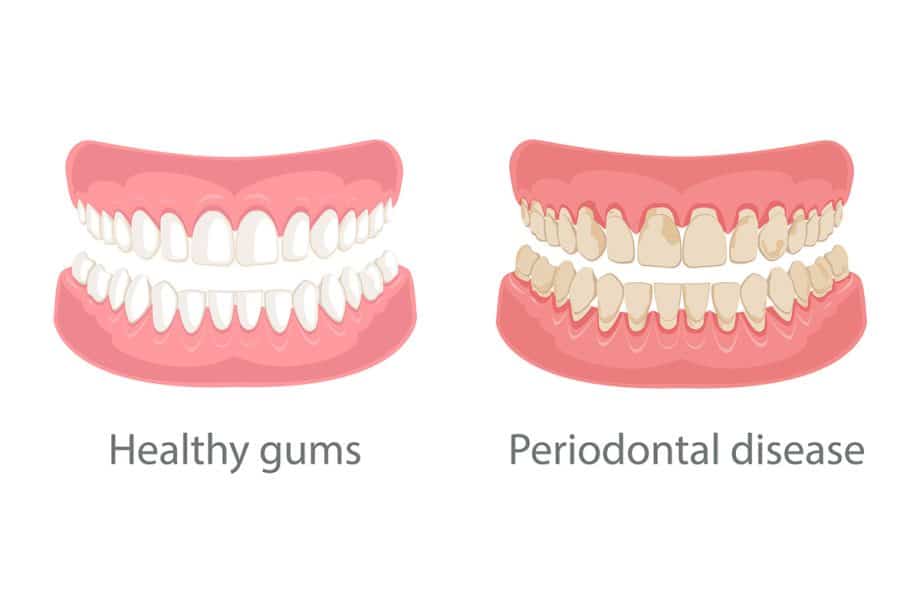Receding gums are a painful and frustrating condition, but the good news is that there are effective ways to treat and prevent it.
In this article, we will explore everything you need to know about receding gums, from the causes and symptoms to the most effective tips and home remedies for fixing this common dental problem. Whether you're looking for natural remedies or professional treatments, we've got you covered. With our expert advice, you'll be armed with the knowledge and tools to take control of your oral health and restore your gums to their full health and beauty.
Say goodbye to discomfort and embarrassment caused by receding gums and say hello to a confident smile.
Understanding Receding Gums: Causes and Symptoms
Receding gums occur when the gum tissue around your teeth starts to wear away, exposing the tooth root. This can lead to sensitivity, tooth decay, and even tooth loss if left untreated. There are several factors that can contribute to receding gums, including:
- Poor oral hygiene: Inadequate brushing and flossing can cause plaque buildup, which can irritate and inflame the gum tissue, leading to gum recession.
- Gum disease: The most common cause of receding gums is gum disease, also known as periodontitis. This bacterial infection can destroy the gum tissue and bone supporting your teeth, causing them to recede.
- Aggressive brushing: Brushing your teeth too hard or using a toothbrush with hard bristles can cause the enamel on your teeth to wear away and your gums to recede.
- Genetics: Some people are more prone to gum recession due to their genetic makeup.
- Hormonal changes: Hormonal fluctuations, such as those experienced during pregnancy or menopause, can make gums more sensitive and prone to recession.
The symptoms of receding gums can vary from person to person, but common signs include:
- Visible tooth roots: If you notice that your teeth appear longer than before and you can see more of the tooth root, it may be a sign of receding gums.
- Sensitivity: Receding gums can expose the sensitive dentin layer of your teeth, making them more sensitive to hot, cold, and sweet foods and drinks.
- Bleeding gums: If your gums bleed easily, especially when brushing or flossing, it could be a sign of gum recession.
- Loose teeth: As gum recession progresses, you may notice that your teeth feel loose or have shifted in position.
- Bad breath: Gum disease and receding gums can cause chronic bad breath that doesn't go away with brushing or mouthwash.
If you experience any of these symptoms, it's important to address them promptly to prevent further damage and ensure the long-term health of your teeth and gums.
Proper Oral Hygiene Practices for Preventing and Treating Receding Gums
Maintaining good oral hygiene is crucial for preventing and treating receding gums. Here are some practices you should incorporate into your daily routine:
- Brushing technique: Use a soft-bristled toothbrush and gently brush your teeth in a circular motion, focusing on the gumline. Avoid aggressive brushing, as it can cause gum recession. Brush twice a day for two minutes each time.
- Flossing: Flossing removes plaque and food particles from between your teeth and along the gumline. Be gentle and slide the floss up and down, following the curve of each tooth.
- Mouthwash: Rinse your mouth with an antimicrobial mouthwash to kill bacteria and freshen your breath. Look for a mouthwash that is alcohol-free to avoid drying out your mouth.
- Regular dental check-ups: Visit your dentist at least twice a year for a professional cleaning and check-up. Your dentist can identify early signs of gum disease and recommend appropriate treatments.
- Avoid tobacco: Smoking and chewing tobacco can contribute to gum disease and gum recession. Quitting or avoiding tobacco products can significantly improve your oral health.
By following these simple yet effective oral hygiene practices, you can maintain healthy gums and prevent further recession. However, if your receding gums are severe or do not improve with these measures, it may be necessary to explore dental procedures for fixing receding gums.
Dental Procedures for Fixing Receding Gums
In some cases, natural remedies and lifestyle changes may not be enough to fully restore receding gums. Dental procedures can provide more targeted and advanced treatments. Here are some common procedures used to fix receding gums:
- Scaling and root planing: This deep cleaning procedure removes plaque and tartar from below the gumline and smooths the tooth root to discourage bacteria buildup and promote gum reattachment.
- Gum grafting: In this procedure, gum tissue is taken from another part of your mouth or a donor source and attached to the area where your gums have receded. This helps cover exposed tooth roots and restore gum tissue.
- Pinhole surgical technique: This minimally invasive procedure involves making small holes in the gum tissue and using special instruments to gently reposition it over the exposed tooth roots.
- Laser therapy: Dental lasers can be used to remove bacteria and diseased tissue, as well as encourage gum regeneration.
Periodontal Procedures in Peoria
Receding gums can be a distressing condition, but with the right knowledge and care, it is possible to treat and prevent further recession. By making lifestyle changes, such as quitting smoking and managing stress, you can significantly improve your gum health.
Additionally, maintaining a healthy diet and incorporating specific nutrients into your meals can promote gum healing and prevent further recession. Over-the-counter products, such as desensitizing toothpaste and therapeutic mouthwash, can provide temporary relief, while professional treatments like scaling and root planing or gum grafts may be necessary for more severe cases.
To determine the best course of action for your specific situation, contact us at 309-674-4148.
